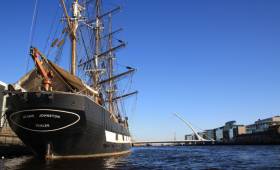Displaying items by tag: Museum tallship
#ShiftingBerths – One of Dublin’s floating tourist visitor attractions on the Liffey, tallship Jeanie Johnston which reopened after a historic drydocking, has still yet to return to her customary city-centre berth, writes Jehan Ashmore.
Jeanie Johnston a replica of a 19th century famine-emigrant tallship had been expected to be towed back to her berth on Custom House Quay. The reason is due to temporary interim closures of the Samuel Becket swing-bridge because of maintenance. Before that the barque as planned was initially given a temporary berth just beyond the Tom Clark lift-bridge (see report photo).
As previously reported on Afloat Jeanie Johnston was to shift berths to Sir John Rogerson Quay. This has since been carried out with tours of the tallship currently available along this southside quay. The tallship is downriver of the distinctive orange coloured Diving Bell which was preserved in recent years.
The museum tallship operator website advises that tour tickets remain on sale at Custom House Quay. A walk of around five minutes from Sir John Rogersons Quay.
The tours explains the role of the original Jeanie Johnston that made 16 emigrant journeys from Ireland to North America between 1847 and 1855. In that time, Jeanie Johnston transported over 2,500 people with no loss of life.
After March 10th, the tours will commence when the ‘Jeanie’ shift berths upriver. This will involve the final leg of a short hop back ‘home’ to the northside’s Custom House Quay.
Jeanie Johnston, the replica that is was built in Blennerville outside Tralee, Co. Kerry. In 2003 she sailed to North America on a tour of ports along the US and Canadian east coast. The historic re-enactment drew considerable positive media attention overseas. This in stark contrast to domestic criticism before the tour arising over high cost-overuns in constructing the replica.
Following her return from the North American tour she made several visits to ports in western Europe. Also day sails in Dublin Bay were run before her short-lived sailing career ended.
The barque was acquired in 2005 by her previous owners the Dublin Docklands Development Authority. The DDDA began using the tallship as a museum ship for the next five years.
Since 2010 Galway-based company Aiseanna Mara Teoranta were appointed to continue operating the ship as a museum.
Reopening of Dublin City Centre Tourist Tallship Deferred
#TallshipTimes - The reopening of a Dublin city centre tourist visitor attraction, the tallship Jeanie Johnston has been deferred by a week, writes Jehan Ashmore.
As reported earlier this week the replica of the 19th century famine-emigrant tallship followed a historic end of era drydocking in the port. The tallship was to have reopened yesterday following a tow to a temporary berth.
It transpires the reopening of tours explaining the emigrant role of the original ship during the Irish famine to north America will begin next Friday, 24 February. This been despite the barque's recent return to a routine berth at Custom House Quay following planned drydocking maintenance.
During a visit to the Jeanie Johnston by Afloat to the drydock, it was clearly evident towards the stern that exposed timber framework remained along with just half a mizzen mast in situ. As for the graving dry-dock dating to 1957, the largest such working facility in the state and in the capital at 200m long is to be decommissioned by the Dublin Port Company.
This is to facilitate DPC’s plans for much needed quay frontage and cargo space for the €227m Alexandra Redevelopment Project (ABR) project. This will be phase one of the port’s Masterplan: 2012-2040.
Following three days of public information days held this week in local community venues on the Masterplan Review, those intending to consult can still do until Tuesday 7th March 2017. Dublin Port is inviting submissions from all those with an interest in the future development of the Port.
DPC have published a Masterplan Review 2017 Consultation Paper and an Environmental Report Consultation Paper. Both documents can also be viewed in hard copy (Monday to Friday, 9am to 4pm) at the offices of Dublin Port Company, Port Centre, Alexandra Road, Dublin 1.
Submissions may be made to Dublin Port Company during the public consultation period in any of the following ways by clicking this information link here.





























































